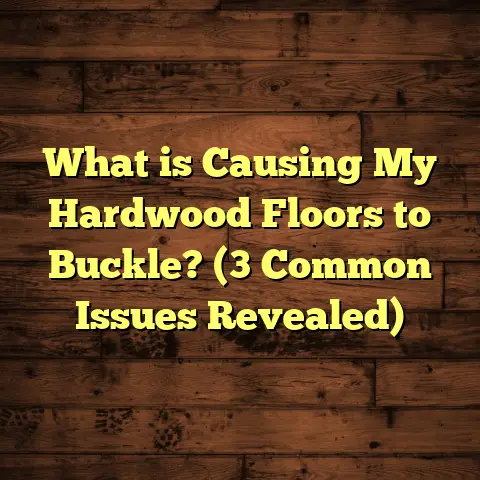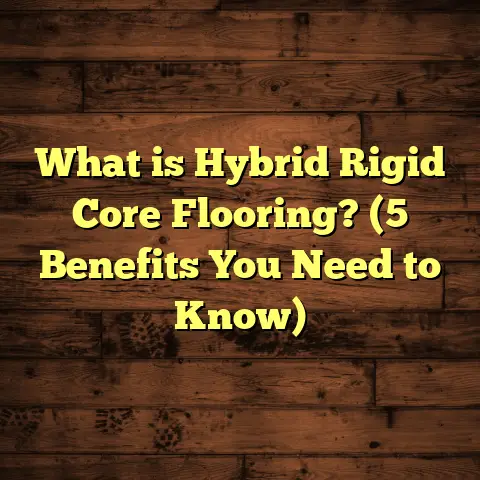What is Flooring? (5 Essential Types You Need to Know)
Eco-Friendly Flooring Choices: Why They Matter to Me
I’ve always cared about how my choices affect the environment, but it wasn’t until I started thinking seriously about flooring in my home that I realized just how big an impact this decision can have. Flooring isn’t just about aesthetics or comfort—it’s also about sustainability, indoor air quality, and resource use. The materials we lay down on our floors can either add to the planet’s problems or help reduce them.
When I first began exploring flooring options, I was surprised by how many products claim to be “green” or “eco-friendly.” But what does that really mean? How do you know if a flooring type is truly better for the environment? These questions led me on a deep research journey—and a lot of hands-on work as a flooring contractor—to understand what flooring is and which types deserve serious consideration.
In this article, I want to share everything I’ve learned about flooring, focusing on five essential types that come up most often. I’ll explain what flooring really is, dive into details about each type, and give you my personal take on their strengths, weaknesses, and environmental impacts. Along the way, I’ll share stories from my projects and how tools like FloorTally have helped me stay on budget without guesswork.
Let’s start with the basics.
What Is Flooring?
At its simplest, flooring is the permanent covering installed over the structural subfloor of a building. It’s what you walk on every day and a key part of your home’s interior design.
But flooring is much more than just a surface. It serves several important roles:
- Protection: It protects the subfloor beneath from damage caused by moisture, wear, and foot traffic.
- Comfort: Flooring choices affect how comfortable a room feels underfoot—hardwood floors feel different from plush carpets or cool tile.
- Insulation: Floors can help regulate temperature and sound inside a home.
- Aesthetics: Flooring sets the tone for the room’s style and can influence mood.
- Safety: Some floorings provide slip resistance or cushioning to prevent injuries.
The subfloor itself is usually made of plywood or concrete and provides the structural base. Flooring materials are installed on top of this base. How they’re installed varies widely depending on the material—some use nails, others glue or click-lock systems.
From a materials perspective, there are countless options—from natural hardwoods to synthetic laminates and everything in between.
Why Flooring Choices Matter More Than You Think
You might wonder why I’m stressing flooring so much. After all, it’s just what you walk on, right? But in my years working as a flooring contractor and consultant, I’ve seen firsthand how important flooring decisions can be.
For example:
- Longevity: A poorly chosen floor can wear out quickly, leading to costly repairs or replacements.
- Indoor Air Quality: Some flooring products off-gas chemicals that can worsen allergies or asthma.
- Environmental Impact: The production, installation, and disposal of floors make up a significant part of a home’s environmental footprint.
- Resale Value: Flooring affects how buyers perceive a home and its market value.
- Maintenance Needs: Different floors require very different care routines.
Because floors cover so much area in a home, their cumulative impact on your lifestyle and the environment is huge.
I remember one job where a client initially wanted cheap laminate for their living room but after discussing durability and emissions concerns, they decided to invest in responsibly sourced hardwood instead. Years later, they told me they’re still thrilled with their choice. Stories like that remind me why it’s worth taking the time to understand flooring fully before making a decision.
Now that we’ve laid out what flooring is and why it matters, let me introduce you to five essential types you should know about.
1. Hardwood Flooring: Timeless Beauty with a Story
Hardwood flooring has been the gold standard for centuries. It offers natural beauty, warmth, and character that few other floorings can match. There’s something about walking barefoot on wood grain that feels connected to nature—something I personally love.
What Hardwood Is Made Of
Hardwood floors are made from solid pieces of wood cut from trees—common species include oak, maple, cherry, walnut, and hickory. Each species has unique grain patterns and colors.
The planks are usually ¾ inch thick and installed by nailing or stapling them onto a wooden subfloor. Because they are solid wood throughout, hardwood floors can be sanded down and refinished multiple times to remove scratches or renew their appearance.
Advantages I’ve Seen Over the Years
- Durability: Hardwood can last 50+ years if taken care of properly. I’ve refinished floors in century-old homes that still looked stunning.
- Aesthetic Appeal: No two hardwood floors are exactly alike. The natural variations add warmth and personality.
- Value Addition: Real hardwood adds significant value to a property; one study showed homes with hardwood floors sold 9% faster than those without.
- Improved Air Quality: Unlike carpets, hardwood doesn’t trap dust or allergens—a big plus for allergy sufferers.
Challenges You Should Know About
- Cost: Hardwood is one of the more expensive floorings—material plus installation can run $6-$15 per square foot.
- Maintenance: Requires periodic refinishing and careful cleaning. Water spills must be wiped quickly to avoid damage.
- Susceptibility to Scratches: Pets or heavy furniture can scratch wood surfaces.
My Experience with Hardwood Floors
I recall installing hardwood in a family’s living room where their children loved running barefoot across the floor. The parents wanted something safe yet beautiful. We chose white oak with a matte finish to hide minor scratches.
Years later, they told me how easy it was to maintain with just occasional refinishing—proof that hardwood’s longevity pays off over time. Plus, knowing the wood was certified from sustainably managed forests made them feel good about their choice environmentally.
Environmental Impact
Hardwood comes from trees, so sustainability matters. Wood harvested responsibly under certifications like FSC (Forest Stewardship Council) ensures forests aren’t depleted. Compared to synthetic floors, hardwood has lower embodied energy—the total energy used to produce it—and can be recycled or repurposed at end-of-life.
2. Laminate Flooring: Affordable Style and Practicality
Laminate flooring offers an affordable alternative that mimics wood or stone appearance without the price tag or care demands of real hardwood or tile.
How Laminate Works
Laminate consists of several layers:
- A fiberboard core for strength
- A photographic layer printed with wood or stone visuals
- A clear wear layer on top for durability
Many laminates use a click-lock system for floating installation—no glue or nails required.
Why Laminate Is Popular
- Cost-Effective: Laminate typically costs $2-$7 per square foot installed.
- Scratch and Stain Resistant: Great for homes with kids or pets.
- Moisture Resistance: Better than hardwood but not waterproof.
- Easy Installation: Many DIYers can handle laminate floors themselves.
Downsides I’ve Seen
- Not Refinishable: Once worn or damaged, laminate must be replaced.
- Can Look Less Authentic: The photographic layer isn’t real wood; some cheaper laminates look plasticky.
- Off-Gassing Concerns: Some laminates contain formaldehyde-based adhesives—always check certifications like GreenGuard.
My Laminate Installation Stories
I once helped renovate a basement where moisture was a concern but the family wanted a warm wood look. Laminate was perfect—it handled occasional dampness better than wood and was easy on their budget.
They loved how fast installation was; we finished in a day. However, after a few years of heavy use in their playroom, some areas showed wear—proof laminate is great short-term but not forever.
Environmentally Speaking
Laminate flooring often uses recycled wood fibers in its core layer but uses adhesives and resins that may have chemical emissions. Choosing laminates with low-VOC (volatile organic compounds) ratings is best for indoor air quality.
3. Vinyl Flooring: Modern Durability Meets Design Variety
Vinyl flooring has evolved tremendously from its early days as cheap linoleum alternatives. Today’s vinyl includes luxury vinyl tile (LVT) and plank (LVP) options that look remarkably like natural stone or wood.
What Vinyl Is Made Of
Vinyl is primarily made from PVC (polyvinyl chloride) combined with plasticizers for flexibility. Modern luxury vinyl has several layers including a wear layer with protective coatings.
Why I Recommend Vinyl in Certain Cases
- Water Resistance: Vinyl shines in kitchens, bathrooms, and basements where moisture is common.
- Comfort Underfoot: Softer than tile or wood due to its vinyl composition.
- Affordable: Installed vinyl costs between $2-$8 per square foot.
- Wide Design Choices: Endless colors and textures available.
Things to Watch Out For
- Environmental Concerns: PVC production involves toxic chemicals; disposal is problematic as vinyl isn’t biodegradable.
- Potential Off-Gassing: Some vinyl floors release VOCs after installation.
- Susceptibility to Cuts: Sharp objects can damage vinyl more easily than tile or hardwood.
Personal Vinyl Installations
One project involved installing vinyl planks in a rental property where durability and ease of cleaning were top priorities. The landlord appreciated how vinyl handled spills and stains better than carpet or laminate.
They also liked how installation was quick with peel-and-stick tiles—great for fast turnovers between tenants.
Greener Vinyl Options Emerging
Some manufacturers now incorporate recycled content into vinyl floors or use phthalate-free plasticizers, reducing environmental impacts somewhat. Still not perfect but heading in the right direction.
4. Tile Flooring: Durable Elegance for Wet Spaces
Tile flooring is often chosen for bathrooms, kitchens, and entryways because of its water resistance and durability.
Types of Tile
- Ceramic Tile: Made from natural clay fired at high temperatures; affordable and widely available.
- Porcelain Tile: Denser, less porous than ceramic; more durable but pricier.
- Natural Stone Tile: Includes marble, granite, slate—offers unique beauty but requires sealing.
- Glass Tile: Mostly decorative; reflects light well but fragile in high traffic areas.
Pros of Tile Floors
- Longevity: Tiles last decades; some historic buildings still have original tile floors.
- Waterproof: Ideal for wet areas.
- Design Flexibility: Tiles come in countless shapes, sizes, colors, patterns.
- Low Maintenance: Easy to clean; occasional grout sealing needed.
Challenges I’ve Experienced
Installation is labor-intensive—requires skilled laborers for proper laying and grout application. Poorly installed tiles can crack or cause water leaks underneath.
Tile floors can feel cold underfoot unless paired with radiant heating systems.
Memorable Tile Project
I once worked on restoring an old Victorian home’s kitchen using hand-painted ceramic tiles sourced from local artisans. The tiles brought history alive while offering modern durability—a balance not easy to find!
The family loved that their kitchen floor was both practical and full of character.
Environmental Factors
Ceramic and porcelain tiles come from abundant natural clay but require high energy for firing during production. Natural stone tiles have mining impacts but last very long if maintained well—a trade-off worth considering.
5. Carpet Flooring: Comfort Meets Style (With Caution)
Carpet adds softness underfoot unmatched by other floorings, making rooms feel cozy and warm—especially bedrooms and living rooms.
Carpet Types
- Natural Fibers: Wool is the most common natural fiber carpet; renewable but pricier.
- Synthetic Fibers: Nylon, polyester, olefin; typically less expensive but may have higher chemical footprints.
- Carpet Tiles: Modular squares allowing easy replacement of damaged sections.
Benefits I Value
- Sound Absorption: Carpets reduce noise significantly—great for multi-story homes or apartments.
- Warmth: Insulates against cold floors better than hard surfaces.
- Variety: Available in endless colors and textures matching any décor.
Downsides You Should Know
Carpet traps dust, allergens, pet dander—can worsen indoor air quality if not cleaned regularly. Stains require immediate attention.
Synthetic carpets may off-gas chemicals; wool carpets are naturally flame resistant without added chemicals but cost more upfront.
My Carpet Installation Stories
I helped install wool carpet in a child’s nursery once—the parents loved how soft it felt underfoot while appreciating wool’s natural fire resistance and eco-friendliness despite higher cost.
For busy households with pets though, synthetic carpets sometimes make more sense due to stain resistance.
Environmental Thoughts on Carpet
Wool carpets biodegrade naturally but require sheep farming which has environmental impacts too. Synthetic carpets rely on petrochemicals but often incorporate recycled plastics today; choosing certified low-VOC options helps indoor air health.
How FloorTally Has Changed My Cost Estimating Process
Estimating flooring installation costs used to be one of my least favorite parts of the job. Trying to calculate materials needed while factoring in waste percentages and labor costs could get complicated fast—and mistakes meant lost time or money later.
That changed when I started using FloorTally. This online calculator helps me:
- Enter exact room dimensions
- Select specific flooring materials
- Adjust waste factors based on installation type
- View local labor rates integrated into estimates
For instance, when planning an engineered hardwood installation last fall, FloorTally gave me accurate quantities needed plus labor cost estimates based on my zip code area—all in minutes. Before this tool, I’d spend hours gathering quotes from suppliers then crunching numbers by hand.
Using FloorTally means fewer surprises mid-project—and happier clients who get realistic budgets upfront without hidden fees cropping up later.
If you’re doing your own calculations or managing multiple projects like me, tools like this are a lifesaver for making informed decisions quickly without guesswork.
Comparing These Flooring Types Side-by-Side
To help you think through your options clearly, here’s a detailed comparison based on my experience combined with industry data:
| Flooring Type | Durability | Maintenance Effort | Average Cost / sq ft Installed | Environmental Impact | Indoor Air Quality | Best Use Cases |
|---|---|---|---|---|---|---|
| Hardwood | Very High | Moderate | $6 – $15 | Good if FSC certified | Low (natural) | Living rooms, bedrooms |
| Laminate | Medium | Low | $2 – $7 | Moderate | Varies (check VOC) | Basements, kitchens |
| Vinyl | High | Low | $2 – $8 | Moderate/Low if recycled content | Moderate | Bathrooms, rentals |
| Tile | Very High | Low | $5 – $20 | Moderate-high (energy intensive firing) | Low | Bathrooms, kitchens |
| Carpet | Medium | High (regular cleaning) | $3 – $10 | Mixed (depends on fiber type) | Can trap allergens | Bedrooms, playrooms |
Wrapping Up My Thoughts on Flooring Choices
I hope sharing my personal insights alongside facts helps you feel more confident picking your next floor. Flooring touches so many parts of life—from comfort to style to environment—that it deserves thoughtful attention.
Hardwood remains my top pick when you want beauty plus longevity—just choose responsibly sourced options. Laminate offers budget-friendly looks with decent durability but plan for replacement eventually. Vinyl suits wet areas well though watch for greener product choices. Tile brings timeless durability at a higher price point with endless design flair. Carpet offers comfort but needs care especially if allergies are a concern.
Whatever you pick:
- Take your time researching products
- Use tools like FloorTally for budgeting accuracy
- Consider your lifestyle needs carefully
- Don’t overlook environmental impacts
If you want any advice on specific products or installation tips—or just want to share your own flooring stories—I’m here anytime!
Thanks for sticking with me through this deep look at flooring—I’m excited to see what you choose for your space!





